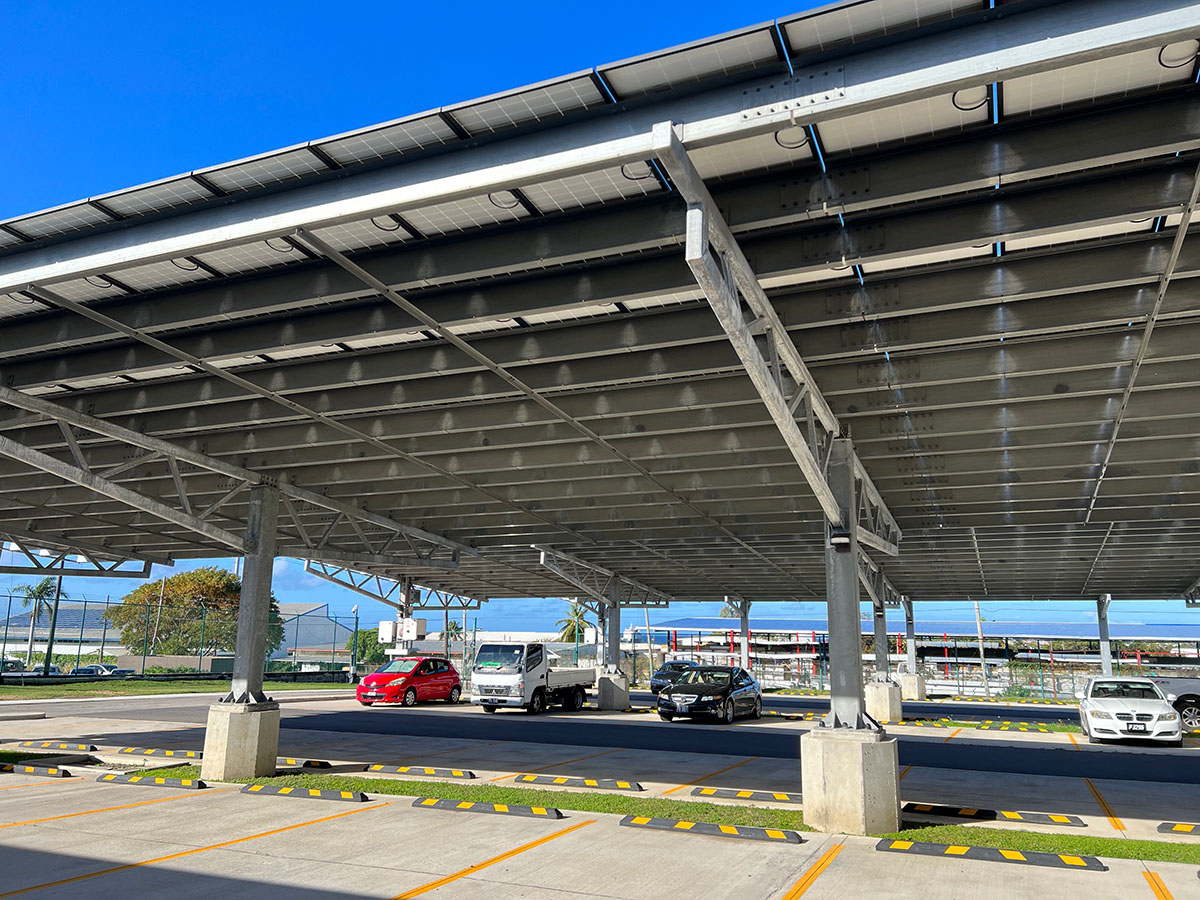The Caribbean Renewable Energy Forum (CREF) awarded its 2023 prize for “Best Microgrid” to Solar Island Energy and the Eastern Caribbean Central Bank (ECCB) for a project on the Caribbean Island of St. Kitts that was designed using HOMER® Pro software. Key features of the microgrid include its design for resilience to tropical hurricanes and corrosion.
The ECCB is leading the promotion of renewable energy throughout the Caribbean region. Headquartered on the island of St. Kitts in the two-island Federation of St. Kitts and Nevis, the ECCB is the central bank for Eastern Caribbean nations, responsible for setting monetary policy, maintaining monetary and financial stability, printing currency and promoting growth and development.

St. Kitts is located on the edge of the Atlantic hurricane belt, which makes it highly vulnerable to cyclones and hurricanes. In an effort to tackle climate change and related extreme weather events, the ECCB has become a key player in the country’s mission to reduce its carbon emissions and become renewably powered by 2030.
In 2017, two powerful hurricanes, Irma and Maria, inflicted severe damage across multiple Caribbean nations and islands, taking lives and devastating infrastructure and economic potential. The historic intensity and record-breaking economic damage also signaled a dangerous escalation in the risk associated with a changing Caribbean climate. Irma was the first recorded Category 5 hurricane ever to strike the Leeward Islands. At the time, it was the most powerful hurricane ever recorded in the Atlantic, with wind speeds of more than 185 miles per hour. Irma caused 52 fatalities and was estimated to have cost $52 billion in damages, according to the U.S. Government Accountability Office.
Spurred by the physical and economic devastation from catastrophic hurricanes, in 2018, Caribbean political leaders declared climate action and disaster resilience to be a matter of their survival. In keeping with those objectives, the ECCB announced its intention to achieve carbon neutrality by the end of 2022. The bank’s leadership decided to install large solar photovoltaic (PV) canopies over parking lots as part of a larger initiative called “The Greening of the Campus.” The first phase of the project was completed in 2020 during the COVID-19 pandemic, and the second phase was completed in 2021. Ultimately, the ECCB installed 3,620 solar panels and 20 inverters with a total capacity of 1,200 kilowatts (kW).
As of April 2022, the ECCB project was the largest solar generator on the island of St. Kitts and “the largest solar-power system in the Eastern Caribbean operated by any entity other than a power company.”
ECCB solar project upgraded to microgrid in 2022
After the solar array was completed, the central bank added a battery storage system, creating a microgrid that could allow the bank to operate independently of the primary electric grid. The final system features 1.2 megawatts of PV and three megawatt hours of batteries.

The ECCB chose Solar Island Energy to design and manage the project. Solar Island Energy President and Founder Marc Lopata is an electrical engineer and microgrid expert specializing in designing distributed energy systems for Caribbean locations.
“I use HOMER Pro software all the time, almost every day,” Lopata said. “It really excels when the electrical load and weather are not consistent.”
Lopata’s typical process is to create a “desktop estimate” with a load curve using past energy consumption, building size and energy intensity, logger data, or sometimes diesel fuel consumption.
“We use HOMER software to sketch out the basic size of the system that will satisfy the load while best meeting the owner’s performance goals,” Lopata explained.
Before designing the central bank’s parking lot PV canopies, Lopata used a data logger to approximate a power curve — a graph showing the energy that would need to be generated. Once Lopata established the basic cost of the system, he began plugging in specific components, modifying financing and other costs to develop a more refined estimate.
Solar Island Energy also participated in the engineering phase of the ECCB solar canopy development and was closely involved during the construction process of the microgrid. Lopata was the engineer-of-record for the three phases of this project.
“Solar Under Storm”: documents best practices for hurricane-prone systems
Given St. Kitts’ location and likelihood of exposure to hurricanes, designing to withstand severe weather was vital to the ECCB project’s success, and Lopata provided the needed knowledge. He is an expert in designing solar systems that can withstand extreme weather conditions, such as the hurricanes that batter Caribbean islands and U.S. coastal areas. Lopata is a contributing author to “Solar Under Storm,” a series of documents published by the Rocky Mountain Institute (RMI). The guide explains the root causes of failures of PV systems during hurricanes and provides best practices for engineers and policymakers in designing more resilient systems.
Over half of Caribbean electric utilities own or operate solar PV as part of their generation mix. PV is the most rapidly growing source of power for many Caribbean nations. With their relatively small populations and lack of heavy industry or extensive transportation infrastructure, Caribbean countries have a low carbon footprint. According to the UN Development Program, as small island states, they contribute to only 1% of the global greenhouse gas (GHG) emissions that are causing the climate crisis. However, they endure a disproportionate impact from extreme weather events. The “Solar Under Storm” report describes massive and repeated damage to critical infrastructure. Lopata said islands must develop strategies to protect these resources from damage during extreme weather events.
During the research process for the guide, “the RMI Team looked at PV systems in the areas most impacted by the severe 2017 hurricane season and asked, ‘Why didn’t these fail?’ We compared that with systems that did suffer damage and analyzed those failure points,” Lopata said.
The design of hurricane-resistant distributed energy systems — particularly PV arrays — is a highly technical process. It involves scrutiny at every level, from the overall placement and configuration of the array and components to how individual nuts and bolts are fastened. Lopata said a few of the best practices described in “Solar Under Storm” include a commitment to financing hurricane resilience, which he said could add a few percent to project costs, and design for wind speeds that conform to new American Society of Civil Engineers recommendations for Caribbean wind loads, with wind tunnel testing of the design highly encouraged. “Solar Under Storm” technical documents also recommend that designers in regions prone to high winds avoid using trackers because they are mounted on a single row of posts and designed to move; failure of that mechanism and unplanned movement during a hurricane could lead to widespread damage. Instead, solar panels should be fastened to storm-resilient racking tables that use front and back row legs. Other best practices include corrosion-resistant stainless-steel hardware, extra clamps on the outer edges of a solar array, and bolts that are checked routinely for proper torque.
ECCB project reduces the facility’s energy bills and carbon emissions
The ECCB estimates that its solar canopy project produced 3.4 million kilowatt hours (kWh) of electricity between December 2019 and mid-January 2022, reducing carbon emissions by 90% or slightly more than 2,700 tons. The PV system generates the equivalent amount of electricity to 1,100 tons of coal annually. It offsets the emissions from over 6 million passenger miles a year, or the equivalent carbon fixation of 1,200 acres of hardwood forest. The PV system also produces more electricity than the bank needs for its operations, so in sunny conditions, when the battery plants are fully charged, that excess energy is exported to the power grid owned by St. Kitts Electric Company (SKELEC).
“The ECCB project had only a six-year payback and is offsetting about 90% of the bank’s energy consumption based on HOMER Pro software modeling,” Lopata said. “The short payback is because it is offsetting diesel electricity, which can cost up to 70 cents per kWh in some locations, and the 90% offset is approximately the lowest levelized energy cost over the project’s lifetime.”
Lopata concluded that the hardening of PV systems in the Caribbean against hurricane damage and corrosion is well worth the expense, at an estimated 2%-3% increase in cost for foundations, hardware and steel.
SKELEC Board Chairperson Nuricer Archibald said in a video interview, “This is the first project of its kind across the federation. Given our plans to be fully renewable by 2030, this project is going to be instrumental in bringing us to that point… What the central bank has done is role model for all of us.”
Learn more about HOMER Pro

UL Solutions’ HOMER® Pro is the leading pre-feasibility design software for modeling microgrids, with more than 250,000 users in more than 190 countries. It provides engineering and financial analyses of remote, off-grid and grid-tied complex distributed energy systems, helping reduce financial risk for owners and developers. Learn more about HOMER Pro and download a complimentary trial.
